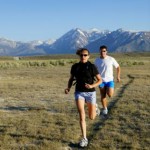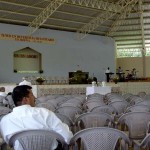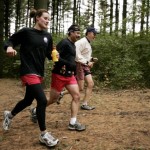If the ekklesia (church) of Christ is God’s children gathered together…
I’ve suggested on this blog (many, many times) that the Greek term ekklesia (which has been translated “church”) refers to a gathering of people (or “assembly”). This means that God’s ekklesia (God’s church) is an assembly of people who belong to him – that is, a gathering of people who are disciples of Jesus Christ.
I’m not suggesting anything that hasn’t been written countless times in books, articles, and posts at other blogs: “ekklesia” refers to an assembly of people. Therefore, “God’s ekklesia” refers to an assembly of God’s people.
(By the way, I’ll use “ekklesia (church) of God” and “ekklesia (church) of Christ” interchangeably, because both phrases are used in Scripture. I use those phrases to designate God’s people gathered together from other assemblies of people. I do not use them to refer to any particular denomination or organization, even if some denomination/organization might use the same phrase to refer to itself.)
What would happen – what difference would it make – if we truly lived and acted as if God’s people gathered together was ekklesia (church)?
… a group of Jesus’ disciples gathered in a home or cafe would be ekklesia, but so would a group gathered in a designate building with a steeple.
… a group of God’s children who do not have recognized leadership would be church, but so would a group that has a hierarchy of leadership.
… a group of believers who meet irregularly would be ekklesia, but so would a group that had regularly scheduled meetings.
… a group of disciples who meet without any activities planned or scheduled would be church, but so would a group that followed a set plan – even a lectionary.
… a group of Jesus’ followers who are eating together would be ekklesia, but so would a group that was singing hymns and listening to a sermon.
Of course, I could go on and on. And, I purposely began with the descriptions that are often used among those who prefer to gather in ways that are more organic/simple/relational/etc. But, I could have swapped the left and right side of the statements above.
We are ekklesia (church) when we are gathered together with other brothers and sisters in Christ.
(Of course, this does NOT mean that every way of living, leading, gathering, etc. together are as beneficial as others. However, THAT is a different point.)
So, I ask again… What would happen – what difference would it make – if we truly lived and acted as if God’s people gathered together was ekklesia (church)?
Report on Simple/Organic/House/Missional Church in the UK and Ireland (2011)
Ben from “MissionBritain” wrote a guest post for me a few months ago called “Building a culture of discipleship.” (If you haven’t read his guest post, please do. It is excellent!)
Last week, he sent me a copy of a report on simple/organic/house/missional churches in the UK and Ireland. You can read more information and download the complete report here: “Simple/Organic/House/Misisonal Church in the UK and Ireland (2011).”
While I would encourage you to read the entire report, I want to highlight a few of the statistics. (By the way, the report is NOT a list of statistics. Instead, it includes much more information, including some suggested steps forward.)
We asked people to describe their simple/organic/house/missional church and the top answer was – “We are a group of Christians seeking to live out New Testament principles/models of church.”
We asked people to describe their journey so far in terms of seeing people baptised.
– Approximately 60% of people said that they had seen some people baptised and discipled.
– No-one said that they had seen many people baptised and discipled.
– 40% of people involved with simple/organic/house/missional church in the UK and Ireland said that “It has been a challenge to keep persevering on this path when it seems that we have seen little fruit from our efforts.”
Do you see the disconnect? While most of the people in the report said they were trying to “live out New Testament principles,” very few were actually baptizing or making disciples. In fact, a large number (40%) said they had seen “little fruit.”
Now, I’m sure these 40% have seen many changes when it comes to church practices, methods of gathering together, and leadership. But, they have seen “little fruit” specifically in terms of baptism and discipleship.
Should we expect “fruit” if we are living according to New Testament principles? If so, is there something missing? What?
Look at your feet; look at the path; look further ahead
When running on roads or sidewalks, I tend to spend most of the time looking ahead, either a few feet down the road or even further. If I’m about to cross from road to sidewalk or if there is a break or curb, then I’ll look down at my feet while I make the change in surface. However, usually, the surface is fairly smooth and regular. So, I usually look ahead to figure out where I’m going to run, to watch for traffic, to make sure I don’t run into someone else.
But, with trail running, things are different. Like I said in my post “Rocks and Roots and Leaves,” when trail running, each step is fraught with danger, some visible and some hidden. While the surface of roads and sidewalks are typically smooth and regular, trail surfaces are completely opposite: there are very few smooth or regular steps along the trail.
So, most of the time, I find myself looking down at my feet when I’m trail running. This tendency has paid off. So far, even though I have tripped or stumbled over a few rocks or roots, I have not fallen yet. Of course, I’ve only run about 10 miles on trails so far.
But, it’s not enough to only watch your feet when trail running. You also must look at the path just ahead of you. Why? Because there are twists and turns in the trail; it dips and rises; there are even trees and limbs to watch out for. If you only look at your feet, you will run into problems, even if you never fall over a rock or root.
But, looking at your feet and looking at the path just ahead of you is still not good enough when trail running. You must also look further ahead. Remember that I wrote about meeting other people on the trail? If you aren’t looking ahead, you may run right into someone else running along the same trail.
Plus, the trail often turns or intersects other trails. The trail that we run (part of the Mountains-to-Sea trail) is marked with white circles (blaze) painted on the trees along the trail. One white blaze means that the trail continues straight ahead. Two blazes means that the trail is about to turn. If you don’t see those blazes, you may end up on the wrong trail.
So, while trail running, for these reasons – and many others – you must keep your eyes on your feet, on the path just ahead of you, and on the trail even further ahead. And, it’s important to watch all three… at the same time… which is impossible of course. So, instead, you glance from one to the other, even if you decided (like me) to spend most of your time watching your feet take each step.
When it comes to where you focus your vision, I think life is much more like trail running than street running. We have to carefully watch each step we take. But, we must also watch what’s going on around us. Finally, we also need to understand where we’re headed.
It’s not easy… some would say impossible. But, if we keep the “eyes” of our lives focused only on one or two of those distances, then we’ll find ourselves in constant trouble.
—————————————
Spiritual Lessons from Trail Running
- Introduction: Spiritual Lessons from Trail Running
- Rocks and Roots and Leaves
- Leading from the front; leading from behind
- It’s a long, hard road, but we’re running it together
- Meeting other people on the journey
- The Destination, the Journey, and Everything In Between
- Look at your feet; look at the path; look further ahead
Scripture… As We Live It #187
This is the 187th passage in “Scripture… As We Live It.”
And while they [Joseph and Mary] were there [Bethlehem] toward the end of December, the time came for her to give birth. And she gave birth to her firstborn son and wrapped him in swaddling cloths and laid him in a manger, because there was no place for them in the inn and the rude innkeeper would not find a place for them but forced them to stay in the barn out back along with several animals, including at least one camel and donkey. (Luke 2:6-7 re-mix)
(Please read the first post for an explanation of this series.)
The Destination, the Journey, and Everything In Between
When I went trail running for the first time a few weeks ago, we planned to run 3.5 miles into the trail to a point where the trail intersects a road. At that point, we rested for 5-10 minutes, then ran back the same 3.5 miles to our starting point.
During the first half of our run (the “out” portion of the “out and back” run), while I enjoyed the scenery and watched the path carefully, that 5-10 minute rest point started looming larger and larger. It was if that half-way mark became my destination and my entire purpose in running that day.
Of course, once we got to the road and stopped for a few minutes, I remember that I still had to run another 3.5 miles. Even though I had reached my mental “destination,” I had not reached my true destination.
In fact, as I was thinking about this on the run back to the starting point (the “back” portion of the “out and back” run), I realized something else. When I reached the “starting point,” while I would have reached another “destination,” that starting point was not my real destination either.
You see, I started running for several reasons. Similarly, I wanted to start trail running for some of those same reasons plus a few other reasons. In reality, those reasons were my “destination,” not a particular point on a trail or a road.
During the run itself, it is easy to lose sight of the real reason (purpose, goal, destination) in running and get caught up in a temporal destination. In fact, it’s possible to get so caught up in a temporal destination that you cause yourself to miss the real destination.
For example, I’ve heard of many runners who run for better health. But, they push themselves so hard on one particular race to have a great finish time or a great average pace that they end up hurting themselves in the process. They forfeit their real goal (better health) because of an injury sustained in order to complete a temporal goal (finish a single race with a certain time).
Obviously, this can happen in life too. We have all heard of people who want to work hard to provide for their family. But they end up working so much that they never spend time with their family or their family ends up falling apart.
Of course, the same thing happens among the church also. In fact, the church is EXCELLENT at setting temporal goals: a certain program or activity, a Bible study or discipleship meeting, a certain amount of money, etc. But, we must always remember that any temporal activity is just that: temporal. We must always keep our true destination in mind… once we know what that destination is.
—————————————
Spiritual Lessons from Trail Running
- Introduction: Spiritual Lessons from Trail Running
- Rocks and Roots and Leaves
- Leading from the front; leading from behind
- It’s a long, hard road, but we’re running it together
- Meeting other people on the journey
- The Destination, the Journey, and Everything In Between
- Look at your feet; look at the path; look further ahead
Replay: New and Improved “One Anothers”
Three years ago, I published a post called “New and Improved ‘One Anothers’.” Now, I don’t know if you’ve noticed it or not, but there are alot of passages in Scripture that instruct us how to interact with “one another.” But, I’ve found that instructions to be just too difficult and idealistic. So, I put together this list of “one anothers” that are a little more realistic. I’m happy to say that (from what I’ve seen) the church is doing a great job of living by these “one anothers.” What do you think?
———————————
New and Improved “One Anothers”
Most Christians are familiar with the “one anothers” of Scripture, such as love one another, serve one another, forgive one another, accept one another, teach one another, encourage one another, be kind to one another… These exhortations worked well for the early church, but now they’re outdated.
The modern church lives by a set of “one anothers” that are both new and improved! While on the surface it may seem that these “one anothers” are negative, in reality they strengthen the church by keeping it from being changed or transformed – just the kind of church that God wants!
Be acquainted with one another
Yes, the Bible said to “love one another”, but we know that we can’t love everyone. So, its much better to be acquainted with people. That way, you can call their name when you pass in the hallway. Name tags are especially helpful in keeping this new exhortation.
Ignore one another
This one is related to “be acquainted with one another”, but its a little more spiritual. We don’t want people to think they they are the center of the universe, so its better to ignore people and their problems, especially when you have something better to do. So, when you ask someone, “How are you?”, if they say something more than “Fine” or “Okay”, its best to simply ignore them.
Ridicule one another
Again, on the surface this looks bad. However, in reality, there is nothing better to get people to have the right theology – MY theology – than to ridicule them and their beliefs. The more theological terms you use while ridiculing them the better. This is especially useful in response to new ideas and suggestions.
Give a little to one another
Keep some change in your pocket in case someone needs something. That way, you have fulfilled your spiritual responsibilities while, at the same time, not costing yourself too much. If you want to be very spiritual, keep an extra one or five dollar bill in your billfold.
Organize one another
People need help knowing what to do and how to do it. Who better to show them than you? Keep people in line, or the church could be in big trouble!
Remind one another of their wrongs
People often forget that they are sinners and that they’ve hurt you in the past. Remind them of this… often… especially if someone good happens to someone. Again, we don’t want people to think too highly of themselves, so its our responsibility to knock them down a notch.
Be served by one another
People like to serve you. Let them… but only a little, and only in insignificant things. You don’t want people to think that you aren’t independent. So, give them little, meaningless jobs to remind them that you are too important to do them yourself.
Kick one another when they’re down
I really don’t have to mention this, because the church is so good at it. But, its always good to have a reminder. When someone falls, make sure you keep them down for a long time. Then, when they get up, don’t help them. They need to learn to stand on their own two feet.
Finally, and perhaps most importantly, smile at one another
No one wants to be around someone who is hurting or sorrowful or depressed. So, put a big smile on your face regardless of your circumstances or how you’re feeling.
As long as the church keeps following these new and improved “one anothers”, the church will continue to make a difference in the world – in the same way that it does now.
We care about Scripture… except at Christmas
Okay, so before you begin reading, you should know something. I’m not opposed to celebrating Christmas. Really, I’m not. I enjoy the tree and decorations; I enjoy giving presents wrapped in colorful paper; I enjoy the songs and carols and stories; I enjoy getting presents wrapped in anything.
But, I was recently talking with my children… yes, for some reason, they’re as sarcastic and skeptical as I am. Anyway, we were talking about Christmas. One of them… I don’t remember which one… said something about the story of Jesus’ birth in Scripture. Later, at work, we had a similar discussion.
So, why do we care so much about Scripture – dotting the i’s and crossing the t’s (or would that be iota’s and tau’s – jots and tittles) – except at Christmas? Here are a few examples:
When (in relation to Jesus’ birth) did Mary speak/sing “The Magnificat” (from Luke 1:46-55)?
How many animals are mentioned in the stories of Jesus’ birth at Christmas? How many animals are in your favorite nativity set or Christmas pageant?
Where was Jesus born according to Scripture? A stall? A barn? A cave? (The word often translated “inn” in Luke 2:7 is also used in Luke 22:11.)
Did the angels sing to the shepherds? (Luke 2:13) (Luke likes the word that used there: Luke 2:20, Luke 19:37, Luke 24:53, Acts 2:47, Acts 3:8, Acts 3:9.)
When did the star/magi (3 Wise Men?) appear in the story? Where did the magi find Jesus? (Matthew 2:11)
Was Jesus born on December 24/25 at night? Did he cry? When exactly did the Little Drummer Boy (my favorite Christmas character/song) appear?
Can you think of other aspects of the typical Christmas story that are not found in Scripture?
Now, it’s not wrong to include these things in our Christmas pageants and songs. But, we should recognize the difference between nice stories/traditions, and Scripture. From talking with many people, most don’t know the difference when it comes to the story of Jesus’ birth.
I wonder if this reflects people’s general knowledge and understanding of Scripture…
Meeting other people on the journey
Where I live, trail running is fairly popular. When we were running through the woods, we crossed paths with other runners who were also running the trails. Most of them were running in the opposite direction from us. Others passed us, or we passed them.
We also met other people who were hiking the trails. The trails that we were running stretch from the mountains of western North Carolina to the beaches of the Outer Banks on the Atlantic Coast. Of course, we only ran a few miles of the 1000+ mile trail system. So, there were local people hiking the trail, and there were backpackers walking from one end of the trail to the other.
The part of the trail that we ran runs near Falls Lake, but it also runs near some subdivisions and homes. Several times, we passed local residents who were out for a morning stroll or who were walking their dogs near their homes (which just happened to be near the trails).
Other runners, hikers, nearby homeowners… we shared the trail with all of these people, but we were all on the trails for different reasons, sometimes even headed in different direction. (In fact, some of the people were not really headed in any direction at all.)
But, even though we were part of different groups and moving in different directions or at different paces, we were not opponents on the trail. Though we may have been tackling the obstacles in different ways and though we may have had different goals, we were able to share the same trail without attempting to force others to change to our ways (or running or pace or direction or whatever).
We were all willing to share the trail with one another – even though those others were different and doing different things.
At times, we moved to one side to allow others to pass by. At other times, other people stepped to one side so that we could run by them. Sometimes, the trail was wide enough for all of us to pass each other safely without stopping.
We did not feel threatened that other people were running on our trail (and in a different way!). We knew what we were there to do, and that’s what we were doing. We even cheered the others on their way, and they often cheered for us as well.
What a difference it would make if the church acted like this. Could you imagine if different sectors of the church (because there are different sectors, even if there shouldn’t be) would cheer each other on instead of bashing each other? Wouldn’t it be incredible if we accepted one another in spite of our differences and tried to help or encourage one another instead of running each other down or tripping each other up.
You know, the weird thing is that none of those other people on the trail – even those who were running the opposite direction – tried to trip me as I ran past. In fact, I honestly think that if I had fallen while running past one of them, they would have offered a hand to help me up.
How much different it is with the church… a group of people that are supposed to be known for their love for one another.
—————————————
Spiritual Lessons from Trail Running
- Introduction: Spiritual Lessons from Trail Running
- Rocks and Roots and Leaves
- Leading from the front; leading from behind
- It’s a long, hard road, but we’re running it together
- Meeting other people on the journey
- The Destination, the Journey, and Everything In Between
- Look at your feet; look at the path; look further ahead
But I thought we were in Nicaragua
A few years ago – before I really started studying the church from the perspective of the New Testament – my family went to Nicaragua with some friends on a mission trip. When we got to Nicaragua, almost everything was new and different because we were in a new and different culture.
But, when we “went to church,” it was like we were back in the southern part of the United States of America – except the language, of course. Even then, I noticed the stark difference between the culture and the church.
I thought about this when I read a post by Felicity at “Simply Church” called “Missions: the bad!”
She writes:
In many nations we have been to, the church resembles any traditional church in the West. The buildings look the same, the people dress in Western clothes for services; they sing translations of Western hymns or songs. Pictures of Jesus portray him as Anglo. The people love God with all their hearts, but Christianity is known as a foreign religion by those outside the church because it looks so different–so Western.
The history of missions shows much insensitivity to local culture. Missionaries, with the best of intentions, confused Christianity and Western culture. They are not one and the same.
The Good News of Jesus transcends culture; it can be contextualized within any culture.
In many places, the damage is done. With great intentions, the gospel was planted along with a Western church culture (the good, the bad, and the ugly of that Western church culture).
But, today, wherever we are, how do we ensure that when we proclaim the gospel we are not also proclaiming our own church culture, whether that is a more institutional church culture or a more organic church culture? (And, you do have a church culture…)
It’s a long, hard road, but we’re running it together
While it is possible to run trails along – and while I’m certain that many people run trails alone all the time – and even do so “successfully” I’m sure – the two times that I’ve been trail running have taught me a very important lessons: There are aspects of trail running that make it very dangerous to attempt to do alone.
In previous posts, I’ve already mentioned the dangers associated with rocks and roots and leaves, and, of course, there are other dangers as well. If you step on a rock or root or slip down a bank on a trail… several miles out in the woods… far away from “civilization”… the result could be disastrous, even for a fairly minor injury.
The first time I went trail running, the people that I ran with taught me the importance of running together. In fact, the “stronger” runners often asked if the pace was too fast, if we needed to slow down, if we needed to rest… As one of them said, “We’re running together. If someone needs to slow down, we all slow down.”
Three people fell on that first 7 mile run. Thank God that none of the three people who fell were injured. But, at each point, the group of runners stopped to check on the one who fell and to help him or her back up. In each case, after brushing him/herself off, the person was able to continue running down the trail.
The next week, when I went trail running again, something a little different happened. Again, a couple of people fell. But, at one point, when one of our friends fell, she had trouble with her knee when she stood back up. She told us that her knee had been injured previously and that the trail was causing her problems again. She did not think she could run, so we all walked with her.
Let me repeat that: One of our group could not run down the trail any longer, so we all walked together.
After walking for a few minutes, our friend wanted to try to run again. She ran for a while, but on a steep uphill climb her knee caused her problems again. So, we walked the rest of the trail.
There were several other people in that group. We could have left the injured runner behind, and the rest of us could have finished a run much more quickly. But, this was not acceptable to us. We were running this trail together – whatever pace that means, even if it means walking.
I think life is most like trail running in this aspect. God brings people into our lives, and we are all in this together. Just as trail runners should never leave an injured member of their party behind, we should never leave an “injured” neighbor behind either. Instead, we must learn to “walk” or “run” together in life as necessary.
—————————————
Spiritual Lessons from Trail Running
- Introduction: Spiritual Lessons from Trail Running
- Rocks and Roots and Leaves
- Leading from the front; leading from behind
- It’s a long, hard road, but we’re running it together
- Meeting other people on the journey
- The Destination, the Journey, and Everything In Between
- Look at your feet; look at the path; look further ahead










